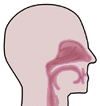  |
||
 |
Septemer 2019ALLODYNGEUSIA- a tastant afterimage the persistence of an oral taste after a robust food or bolusAllodyngeusia, the persistence of an oral taste after a food or drink bolus is imbibed is similar to that of an afterimage after a strong light is presented to the visual system. This type of oral afterimage usually arises after intake of a full flavored food or a strong, flavorful beverage. The effect may persist for seconds, minutes or even hours depending upon the strength of the oral bolus, and the degree of binding of the tastant to the oral receptors-the tighter the binding, the longer the persistence of the allodyngeusia. For food, spicy foods or foods flavored in heavy salt or sweetness can do this. A jalapeno pepper is a common stimulus initiating allodyngeusia. The biochemical cause of allodyngeusia relates to the persistent binding of tastants to their normal receptors in the oral cavity. This can occur in normal people in the absence of any taste loss but it is also common in patients with taste loss of some degree (hypogeusia). The usual binding constant of a tastant to an oral receptor is about 10-3 M. With allodyngeusia however, the binding constant is tighter, e.g. 10-5 -10-7 M, which causes the subject to perceive the oral stimulus and for it to persist after it is swallowed. Over time, when the tastant –receptor binding is coupled, the tastant is perceived and persists, hence the tastant afterimage. However, over time the tastant-receptor complex is uncoupled, the tastant is no longer receptor bound, and the tastant afterimage disappears. A similar event occurs for olfactory stimuli and is called ALLODYNOSMIA, which is defined as a olfactory afterimage similar to that which occurs for tastants. For this to occur strong odors act in a similar manner on olfactory receptors as a strong tastant acts for taste receptors with tighter receptor binding of the odorant to its receptors. For another example see the reference below. References
|
|